Vanilla Cultivation Guide:
Introduction of Vanilla Cultivation:
Vanilla is a tropical climbing vine of the orchid family, grown for its pleasant flavor. Vanilla is one of the costliest spices in the market after saffron and grows with the support of bark of trees. There are more than 40 species of vanilla exist. However, only three of them are considered as important ones. Vanilla planifolia Andrews is the variety widely cultivated on large scale. This cultivar (variety) has more commercial value for its vanillin. Vanilla vine is perennial in nature which belongs to the family of “Orchidaceae” and genus of “Vanilla”. Madagascar is the top producer of vanilla in the world. Usually, Vanilla plants start the first yield after 3 years of planting and continue to give the yield up to 12 to 14 years. Generally, the vanilla crop is grown as an intercrop in the fields of ‘coconut’ and ‘areca nut’. As India is concerned, Indian exports of vanilla multiplied rapidly and accounted for approximately 2% of world vanilla exports. In India, Karnataka tops the country’s vanilla cultivation followed by Kerala and Tamil Nadu states. The vanilla vines can be grown in indoors, greenhouse even in pots and containers. The initial investment for the cultivation of vanilla is little when compared to other spices. Vanilla also can be grown hydroponically. Vanilla gives higher yields when it is grown under shade net or as a pure crop rather cultivating as intercrop. Basically, Vanilla is a tropical orchid crop which requires high humidity, shade, and moderate temperatures. Due to this fact, the demand for cultivating vanilla in shade houses fitted with micro-sprinklers for creating the required micro-climate is increasing in India. In India, as natural self-pollination is not possible, artificial pollination is carried out to effect fertilization and fruit set.
Major Vanilla Production Countries:
The following are the top 10 production countries of Vanilla.
1. Madagascar.
2. Indonesia.
3. China.
4. New Guinea.
5. Mexico.
6. Turkey.
7. Tonga.
8. Uganda.
9. French Polynesia.
10. Comoros.
Health Benefits of Vanilla:
The following are some of the health benefits of vanilla extract.
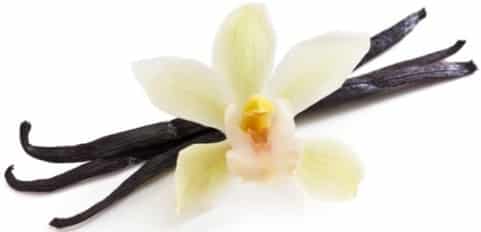
- Vanilla extract helps in healing burns, wounds, and cuts.
- The vanilla extract promotes healthy skin.
- The vanilla extract has anti-aging properties.
- The vanilla extract is best for treatment for acne.
- The vanilla extract promotes healthy hair.
- The vanilla extract helps in treating anxiety and depression.
- The vanilla extract aids in weight loss.
- The vanilla extract relieves nausea.
- The vanilla extract relieves digestive disorders.
- The vanilla extract is good for dental health.
Local Names of Vanilla in India:
In most of the Indian languages, vanilla is called ‘vanilla’.
Climate Required for Vanilla Cultivation:
Basically, Vanilla crop requires warm and humid conditions for its growth. This crop also requires a well distributed annual rainfall of 150 to 350 cm. A temperature range of 25 °C to 34°C is best for vanilla cultivation. Vanilla can be grown above mean sea level (MSL) of 1400 meters. Vanilla crop prefers more than 45% shade and grows well under filtered light. The area where these conditions are not met, vanilla cultivation can be taken in shade house/nets fitted with micro -sprinklers and foggers.
Soil Requirement for Vanilla Cultivation:
The vanilla crop grows well in loose and friable soils with any of loamy texture. However, it requires high organic matter content in the soil for better yield. Well-drained soils are important for vanilla cultivation and it prefers lands with a gentle slope. The required soil pH range for Vanilla cultivation is 6.5 to 7.5. Western Ghats areas in India are best suited for vanilla cultivation as these soils are rich in organic matter and humus. These soils are also having excellent drainage. If you are planning for commercial cultivation of the vanilla crop, make sure to go for a soil test and fill any nutrient gaps based on the soil test results.
Land Preparation for Vanilla Cultivation:
Give a couple of ploughings to bring the soil to a fine tilth stage and remove any weeds from previous crops. Soil should be prepared to drain out the water. In case of the soils which are not fertile, make sure to supplement the organic manure during land preparation. As vanilla vines need support to grow, any kind of living trees or rock pillars, iron pillars can be arranged for supporting the vanilla vines.
Read: Profitable Planting Techniques.
Propagation, Planting, and Spacing in Vanilla Cultivation:
The vanilla crop is propagated by shoot cuttings or seeds. However, shoot cutting method is followed in commercial cultivation of the vanilla crop. The reason being is the seed propagation is very difficult to establish a vanilla orchard as the seeds are very small. When you select the planting material there are two options; one is longer cuttings and other is shorter cuttings. Longer cuttings start flowering in the second year itself whereas short cuttings take 3 years to flower. However, longer cuttings have slow growth when compared to shorter ones. It’s up to you judge the cutting length depending on the availability of material and the area to be planted. Strong, healthy and actively growing vines should be selected as planting material in vanilla cultivation. Shoot cuttings preferably having 8 to 10 internodes should be selected as planting material as these flowers earlier than the shorter cuttings.
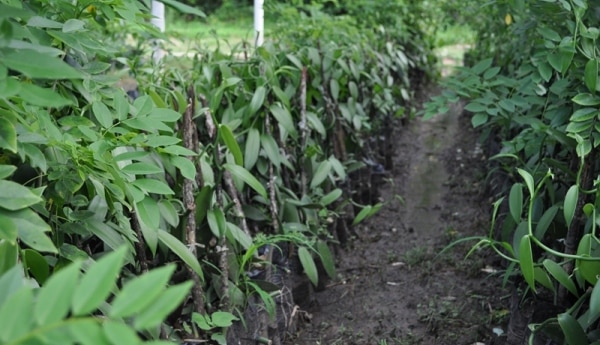
The ideal planting time for the vanilla orchard is when there is moisture present in the weather which is not too rainy or dry conditions. Cuttings should be close to the base of the support. Make sure that the vines are not directly exposed to the sun in the afternoon by planting the cuttings in the North East direction.
As vanilla vines need support to grow, provide any support such as living trees, wooden stakes, stone pillars or any iron pipes. Vanilla cuttings should be planted in the soils which have a medium in organic content. Well-decomposed organic manure or vermicompost should be filled in the trenches made at a spacing of 8 ft. in these trenches support pillars of 7 ft long should be placed at a spacing of 6 ft. Two cuttings of each should be planted around one pole. As per this spacing, the vanilla plant density would be around 2400 to 2500 vines per acre. These vines should be trained on GI wires tied between the pillars at 5 ft height.
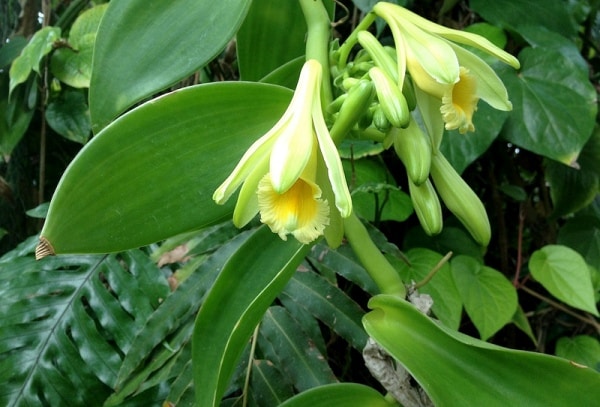
Creation of Micro-Climate in Vanilla Cultivation:
Vanilla plants produce more yields in a controlled environment like greenhouse and shade nets. In this environment, the required humidity, light, and temperatures can be maintained which is pretty much essential for commercial cultivation of vanilla. Any net providing 60% of shade can be considered and support of 12 feet pillars can be used to provide required shade. For proper irrigation and humidity requirement, micro-sprinklers with both irrigation and misting/ fogging facility should be installed in the shade net house.
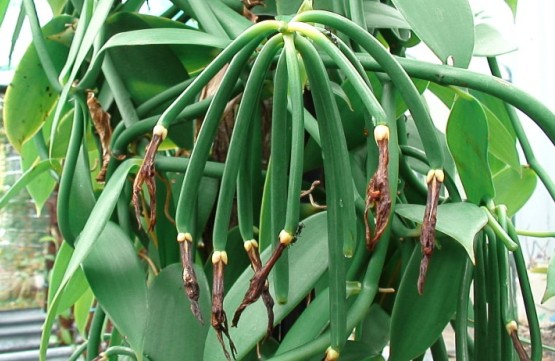
Flowering and Pollination in Vanilla Cultivation:
Usually, Vanilla plants start flowering from the third year of planting during January and February month. Irrigation should be stopped during the month of December and the tips of the vines should be pruned. During this stage, abundant irrigation should be provided to induce more flowers. Natural self-pollination is not possible in India because of the absence of specific pollinating agents. However, artificial pollination should be carried out by hand with the help of a pointed bamboo splinter a stiff grass or a sharpened toothpick to get fruit set. The best time for pollination is 7 am to 12 p.m. On average, a skilled worker can pollinate 1000-2000 flowers/day. It is preferred to pollinate only the first formed 7-10 flowers on the lower side of the inflorescence. It is also recommended to maintain only 10-12 inflorescences per each vine in order to get beans with maximum length and girth and of high-quality standards. The flowering is spread over a period of 3 weeks.
Read: Top 10 Banks Providing Poultry Farm Loan.
Intercultural Operations in Vanilla Cultivation:
Mulching, irrigation, shade management and trailing are main intercultural activities in vanilla plantation.
- Mulching in Vanilla Cultivation: Dried leaves or coconut leaves or husks can be used as mulch material to protect the soil from erosion, moisture loss. Mulching also helps in weed control and enriches the soil fertility.
- Manures and Fertilizers in Vanilla Cultivation: Vanilla crop responds very well to organic manure. Well-decomposed farmyard manure (FMY) like cow-dung or vermicompost or organic inputs such as neem cake can be applied as manures in vanilla cultivation. Apply 125 grams of Nitrogen (N) in the farm of leaf mold in 2 split doses in June-July and Sept-Oct months. To spread the vanilla plant roots, loose soil structure is essential which can be achieved through organic debris. Spraying vermi-wash to the foliage will result in good growth and yield.
- Irrigation in Vanilla Cultivation: Irrigation plays a major role to achieve high yields. First 2 to 3 years after planting the vanilla seedlings, regular watering is required especially during dry and hot summer seasons. It requires irrigation once in 2 days. Sprinkler irrigation is ideals for vanilla cultivation as it is best suited for micro-climate (absorption of moisture from the atmosphere). One can opt for micro irrigation or drip irrigation as well. Water stagnation or flooding should be avoided as this crop is very sensitive to these conditions.
- Trailing in Vanilla Cultivation: In order to limit the growth of the plant, the trailing operation should be carried out. In a vanilla orchard, vine growth should be limited to 150-160 cm height to facilitate easy manual pollination. The vanilla vines should be trailed by coiling them around the branches of the support pillars or on horizontal support without allowing the vines to touch the ground.
Pests and Diseases in Vanilla Cultivation:
The following pests are found in vanilla cultivation:
- Vanilla bug:
- Symptoms: Sucks the sap from buds which leads to rotting.
- Control measures: Collect the egg mass at first nymph stage (In Nov-Feb).
- Beetle:
- Symptoms: These insects eat the lower surface of the leaves.
- Control measures: Collect and destroy. Spraying 0.1% Malathion can also control this.
- Vanilla vine weevil:
- Symptoms: These insects bore into and eat leaves and tender stems.
- Control measures: Collect and destroy the weevils during the adult stage in Nov-Feb months.
- Caterpillar: These feed on vegetative shoots.
- Symptoms: These insects bore into and eat leaves and tender stems.
- Control measures: Collect and destroy these insects.
- White grubs:
- Symptoms: These insects feed on roots and ultimately destroy the vine roots.
- Control measures: Drench the soil at the base with 0.05% Chloropyriphos.
- Achatina:
- Symptoms: These insects feed on young leaves and shoots.
- Control measures: Collect and destroy. Avoid mulch material that does not decompose easily.
The following are the common diseases found in vanilla cultivation:
- Root rot:
- Symptoms: This disease causes yellowing of leaves and stems. Roots become brown leading to rooting and decay.
- Control measures: Remove the affected roots, reduce the mulch and soil drench. Spray the vines with 0.2% coc @ 3 liters per plant.
- Stem Blight:
- Symptoms: It causes brown spots on leaves and stems followed by changing the color of leaves to yellow results in rotting stem and leaves.
- Control measures: This can be controlled by spraying 1% Bordeaux mixture.
- Stem rot:
- Symptoms: This disease causes the stem to become brown color and rotting of tissues.
- Control measures: Remove and destroy the affected area. 0.2% of Carbendazim (2 grams/liter of water) can be sprayed. Repeat the application after 1 month.
- Bean rot:
- Symptoms: This disease causes rotting and shedding of vanilla beans.
- Control measures: Spraying 0.4% Potassium Phosphonate will check this.
- Bean Shedding:
- Symptoms: This disease causes yellowing of immature beans at tips, followed by splitting of the beans and shedding.
- Control measures: Spray 0.2% Carbendazim at 2-week interval.
- Shoot tip rot:
- Symptoms: This disease causes decaying of shoot tip and leaves at the tip.
- Control measures: Spraying 0.2% Carbendazim at 2-week interval.
Note: Contact your local department of Horticulture for pests and disease symptoms and their control. They are the best source for pest control solutions in vanilla cultivation.
Read: Greenhouse Farming Training.
Harvest and Process in Vanilla Cultivation:
The vanilla beans develop very quickly and obtain a full size in 6 weeks after pollination and manuring. However, it takes beans 8-11 months for getting matured. Vanilla is ready for harvest between 6 and 9 months after flowering when the pods are still dark green and the tip is beginning to turn yellow. The vanilla beans should be harvested when the distal end turns pale yellow in color. Generally, on an average, 80 to 90 mature beans make 1 kg of vanilla. There are different stages involved to get the final product. Curing, sweating, drying, and conditioning are the stages involved.
- Curing: Dipping the vanilla beans in hot water at 63-65oC for 3 to 4 minutes.
- Sweating: Exposure to sunlight for 2 hours by spreading them on a raised platform every day for 5-6 days.
- Drying: Keeping the beans spread on racks in an airy room for up to 1 month.
- Conditioning: Keeping the dried vanilla beans bundled and covered in butter paper, in wooden boxes for about 3 months.
Vanilla Dried Beans.
Yield in Vanilla Cultivation:
Yield depends on many factors such as soil, irrigation, and cultivar. The following table shows the vanilla yield.
| Year. | Yield (Green) in Grams/Plant. |
| Third | 250. |
| Fourth | 500. |
| Fifth | 750. |
| Sixth to Fifteenth | 1000. |
Price and Marketing of Vanilla:
As we said before in this article, vanilla is the costliest spice after saffron. The market price of fresh vanilla beans is about 3500 Rs/kg. However, once assume a price of 500 Rs/kg of green pods (Note: this price for green pods). When marketing is concerned, there are herbal, pharmaceutical, food processing companies who can buy vanilla beans in bulk. It is very important to have a proper marketing plan if the vanilla crop is grown commercially on a large scale.
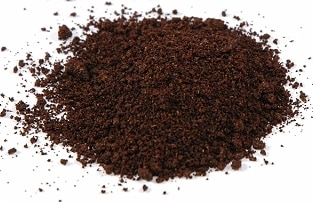
Bottom Line of Vanilla Cultivation:
There are subsidies available from local agriculture departments and banks. Growing vanilla in shade net houses with a unit holding size of 1 acre is technically feasible, financially viable and bankable.
Read: Bonsai Gardening Techniques.
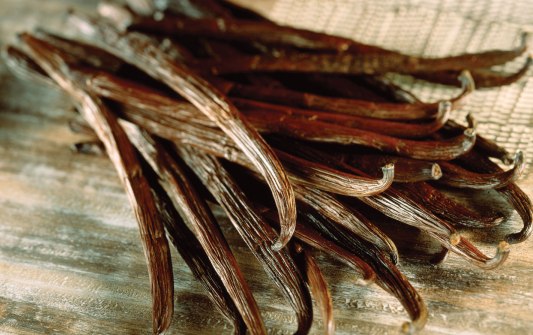
Where can I get the plants. I want to start vanilla farming
Sir, I have interest in growing vanilla plant, so please help me.
Hello There,
I am interested and looking forward to start Vanilla farming in my own farm. Please help me to grow the vanilla plant.
I just want farming guidance for the same or please share contact no.
Thanks,
Indrayan
I need saplings of vanilla. Where can I get these. Can anyone please share info about this crop at sanjeevkalluri@gmail.com
I am in zambia and would wish to go into commercial cultivation of Vanilla at a large scale and possibly have an outgrower scheme with small scale growers.
Hi Edward,
I am interested in cooperation with start large vanilla farm. I have a funding to make it on big scale
I live in the region where there’s a land in bulk, however nobody noticed that. I’m happy to work with anybody who’s eager to invest in such area.
we are an agricultural consultant, at the moment speacializing with vanilla growing, planting, harvesting, curing etc.you can get incontact with us for more information. thank denish
I’m interested in farming vanilla. Please assist with information
HI, I am interested in vanilla farming. We plan to start with 1.24 Acres (0.5Ha) with 1,000 plants. But I don’t have an idea on costing to be incurred.
I need your assistance.
Hi frnds, I’m interested in vanilla farming.
Dont know where to start,can you guys please assist me in this regard.
I am Starting a vanilla farm in Costa Rica anyone interested to partner please contact Vikasattri@sjtimber.com
I am interested in commercial vanilla cultivation. Please advise me on the most high priced species and the farming methods. Also highlight some of the market prices.
Best regards,
Simon Giran
Thank you Sir for the information. I am from Papua New Guinea. I would like to farm vanilla for commercial purposes.
Please kindly advise me on the high yielding and high market demand species that I can farm.
Would really appreciate your response.
Thank you
Which place I get training for vanilla farming procedure
thanks 4 the knowledge
Hai I am planning to start vanilla farming in my farm I am planning to plant in 1acres in arecanut farm and 1acres of teak farm I am from India Karnataka so please give me the information regarding vanilla plantations
Hi
I live in Coimbatore
Would like to know more about vennila cultivation
Can you please throw some light on where to procure saplings
Will we get trained for this type of cultivation
Thanks information. Really interested in starting commercial farming of Vanilla,Land is available and any cooperating partners willing to do a joint venture are welcome.Contact me if interested and able to finance the project,humphreychisenga@yahoo.com
Nicely explained. In India cultivates should cultivate more and more as the climate is more suitable. Marketing must be guided. Thanks.
We resell vanilla beans in the US. I would like to work with one of the smaller growers for a supplier. Any information will be helpful.
i have been following these articles about from this website and it has been productive on my vanilla farming
Hi I am planning start a Vanilla farming at my village so kindly please suggest me how to start a vanilla farming at my village and where can i get the plant or vanilla seed.
Planning to do vanilla farming. Asking if you can send me instructions guides or training method of how to grow
and care for vanillas. (Advantages & Disadvantages.)
Levi. C
Papua New Guinea
I like to be family of vanilla but it seems it cost alot of money!!!
I am a vanilla farmer in Papua New Guinea. I produces great quality of vanilla because the soil and climate here is very conducive. However I need a good market and buyer for my vanilla beans. Where can I export my vanilla beans to? Please reply me ASAP through my email address given above.
Hello Hiale,
Can I get vanilla plant from you?
Best Regards
Minar Islam
I want to start Vanilla in my own farm in South of Viet Nam soon and I’m looking for corp with who has fun or market for export in the large scale of my farm.
Hi, I am from Coimbatore, tamilnadu and I am interested to know the place to buy saplings. Could anyone guide me through? Thanks and good day.
Hi, are vanilla plants can be planted at any conditions or not….??
I am interested to grow Vanilla from Tanzania
I’m interested in vanilla farming ( greenhouse) in Kenya. Anyone with vines around Nairobi?
I’m interested in vanilla farming but I need more guidance and support
I’m interested in vanilla farming.I’m from Nepal.Could you help me to get vanilla plants?
Good information
Please where do I buy the seedlings for my commercial farm.
I want know if l can get l crops of vanilla
I would like to go for Vanilla Farming Course. Please assist with information.
I would to go for the training course for the vanilla farming